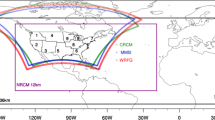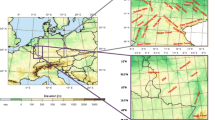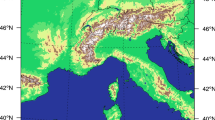Abstract
Three different resolution (50, 12, and 1.5 km) regional climate model simulations are compared in terms of their ability to simulate moderate and high daily precipitation events over the southern United Kingdom. The convection-permitting 1.5-km simulation is carried out without convective parametrisation. As in previous studies, increasing resolution (especially from 50 to 12 km) is found to improve the representation of orographic precipitation. The 50-km simulation underestimates mean precipitation over the mountainous region of Wales, and event intensity tends to be too weak; this bias is reduced in both the 12- and 1.5-km simulations for both summer and winter. In south–east England lowlands where summer extremes are mostly convective, increasing resolution does not necessary lead to an improvement in the simulation. For the 12-km simulation, simulated daily extreme events are overly intense. Even though the average intensity of summer daily extremes is improved in the 1.5-km simulation, this simulation has a poorer mean bias with too many events exceeding high thresholds. Spatial density and clustering of summer extremes in south–east England are poorly simulated in both the 12- and 1.5-km simulations. In general, we have not found any clear evidence to show that the 1.5-km simulation is superior to the 12-km simulation, or vice versa at the daily level.












Similar content being viewed by others
Notes
-
The line joining the mouths of the River Exe and the River Tees in UK.
-
Often called the “growth rate” in hydrology.
-
Only 1.5-km model simulated SE DJF 50+ mm/day event statistics are shown due to the lack of events in the other datasets.
-
The average spatial event density multiplied by the surface area.
References
Allan RP, Soden BJ, John VO, Ingram W, Good P (2010) Current changes in tropical precipitation. Environ Res Lett 5(2):025205. doi:10.1088/1748-9326/5/2/025205
Allen MR, Ingram WJ (2002) Constraints on future changes in climate and the hydrologic cycle. Nature 419:224–232
Antic S, Laprise R, Denis B, de Elía R (2006) Testing the downscaling ability of a one-way nested regional climate model in regions of complex topography. Clim Dyn 26(2–3):305–325. doi:10.1007/s00382-005-0046-z
Arakawa A (2004) The cumulus parameterization problem: past, present, and future. J Climate 17(13):2493–2525. doi:10.1175/1520-0442(2004)017<2493:RATCPP>2.0.CO;2
Arakawa A, Lamb VR (1977) Computational design of the basic dynamical processes of the UCLA general circulation model. Methods Comput Phys 17:173–265
Besag JE (1977) Comments on ripley’s paper. J R Stat Soc 39(2):193–195
Blackburn M, Methven J, Roberts N (2008) Large-scale context for the uk floods in summer 2007. Weather 63(9):280–288. doi:10.1002/wea.322
Charney JG, Phillips NA (1953) Numerical integration of the quasi-geostrophic equations for barotropic and simple baroclinic flows. J Meteorol 10:71–99. doi:10.1175/1520-0469(1953)010<0071:NIOTQG>2.0.CO;2
Davies T, Cullen MJP, Malcolm AJ, Mawson MH, Stainforth A, White AA, Wood N (2005) A new dynamical core for the Met Office’s global and regional modelling of the atmosphere. Q J R Meteorol Soc 131(608):1759–1782. doi:10.1256/qj.04.101
Dee DP, Uppala SM, Simmons AJ, Berrisford P, Poli P, Kobayashi S, Andrae U, Balmaseda MA, Balsamo G, Bauer P, Bechtold P, Beljaars ACM, van de Berg L, Bidlot J, Bormann N, Delsol C, Dragani R, Fuentes M, Geer AJ, Haimberger L, Healy SB, Hersbach H, Hölm EV, Isaksen L, Kallberg P, Köhler M, Matricardi M, McNally AP, Monge-Sanz BM, Morcrette JJ, Park PK, Peubey C, de Rosnay P, Tavolato C, Thêpaut JN, Vitart F (2011) The ERA-Interim reanalysis: configuration and performance of the data assimilation system. Q J R Meteorol Soc 137(656):553–597. doi:10.1002/qj.828
Déqué M, Piedelievre JP (1995) High resolution climate simulation over Europe. Clim Dyn 11:321–339
Efron B, Tibshirani RJ (1993) An introduction to the bootstrap, monographs on statistics and applied probability, vol 57. Chapman and Hall, New York
Ensor LA, Robeson SM (2008) Statistical characteristics of daily precipitation: comparisons of gridded and point datasets. J Appl Meteorol Clim 47:2468–2476. doi:10.1175/2008JAMC1757.1
Essery R, Best M, Cox P (2001) MOSES 2.2 technical documentation. Hadley Centre Technical Note 30, Hadley Centre, Met Office, Fitzroy Road, Exeter, UK
Faulkner D (1999) Flood estimation handbook, vol 2. Rainfall frequency estimation. NERC Centre for Ecology and Hydrology
Fowler HJ, Ekström M (2009) Multi-model ensemble estimates of climate change impacts on UK seasonal precipitation extremes. Int J Climatol 29:385–416
Fowler HJ, Ekstrom M, Blenkinsop S, Smith AP (2007) Estimating change in extreme European precipitation using a multi-model ensemble. J Geophys Res 112(D18):art No. D18104
Giorgi F, Marinucci MR (1996) An investigation of the sensitivity of simulated precipitation to the model resolution and its implication for climate studies. Mon Weather Rev 124:148–166. doi:10.1175/1520-0493(1996)124<0148:AIOTSO>2.0.CO;2
Golding BW (1998) Nimrod: a system for generating automated very short range forecasts. Meteorol Appl 5:1–16
Gregory D, Rowntree PR (1990) A mass-flux convection scheme with representation of cloud ensemble characteristics and stability dependent closure. Mon Weather Rev 118:1483–1506. doi:10.1175/1520-0493(1990)118<1483:AMFCSW>2.0.CO;2
Hohenegger C, Brockhaus P, Schär C (2008) Towards climate simulations at cloud-resolving scales. Meteorol Z 17(4):383–394. doi:10.1127/0941-2948/2008/0303
Hong SY, Leetmaa A (1999) An evaluation of the ncep rsm for regional climate modeling. J Climate 12(2):592–609. doi:10.1175/1520-0442(1999)012<0592:AEOTNR>2.0.CO;2
Jones RG, Murphy JM, Noguer M (1995) Simulation of climate change over Europe using a nested regional–climate model. I: assessment of control climate, including sensitivity to location of lateral boundaries. Q J R Meteorol Soc 121:1413–1449
Jones RG, Murphy JM, Noguer M, Keen AB (1997) Simulation of climate change over Europe using a nested regional–climate model. II: comparison of driving and regional model responses to a doubling of carbon dioxide concentration. Q J R Meteorol Soc 123:265–292
Kendon EJ, Roberts NM, Senior CA, Roberts MJ (2012) Realism of rainfall in a very high-resolution regional climate model. J Climate 25:5791–5806. doi:10.1175/JCLI-D-11-00562.1
Knote C, Heinemann G, Rockel B (2010) Changes in weather extremes: assessment of return values using high resolution climate smulations at convection-resolving scale. Meteorol Z 19(1):11–23. doi:10.1127/0941-2948/2010/0424
Laprise R, de Elía R, Caya D, Biner S, Lucas-Picher P, Diaconescu E, Leduc M, Alexandru A, Separovic L (2008) Challenging some tenets of regional climate modelling. Meteorol Atmos Phys 100(1-4):3–22. doi:10.1007/s00703-008-0292-9
Lean HW, Clark PA, Dixon M, Roberts NM, Fitch A, Forbes R, Halliwell C (2008) Characteristics of high-resolution versions of the Met Office Unified Model for forecasting convection over the United Kingdom. Mon Weather Rev 136:3408–3424. doi:10.1175/2008MWR2332.1
Leduc M, Laprise R (2009) Regional climate model sensitivity to domain size. Clim Dyn 32(6):833–854. doi:10.1007/s00382-008-0400-z
Lilly DK (1962) On the numerical simulation of buoyant convection. Tellus A 14:148–171
Maraun D, Rust HW, Osborn TJ (2009) The annual cycle of heavy precipitation across the United Kingdom: a model based on extreme value statistics. Int J Climatol 29(12):1731–1744. doi:10.1002/joc.1811
Meehl GA, Karl T, Easterling DR, Changnon S, Changnon D, Pielke R Jr, Evans J, Groisman PY, Knutson TR, Kunkel KE, Mearns LO, Parmesan C, Pulwarty R, Root T, Sylves RT, Whetton P, Zwiers F (2000) An introduction to trends in extreme weather and climate events: observations, socioeconomic impacts, terrestrial ecological impacts, and model projections. Bull Am Meteorol Soc 81(3):413–416. doi:10.1175/1520-0477(2000)081<0413:AITTIE>2.3.CO;2
Molinari J, Dudek M (1992) Parameterization of convective precipitation in mesoscale numerical models: a critical review. Mon Weather Rev 120(2):326–344. doi:10.1175/1520-0493(1992)120<0326:POCPIM>2.0.CO;2
Perry M, Hollis D, Elms M (2009) The generation of daily gridded datasets of temperature and rainfall for the UK. Met Office National Climate Information Centre, FitzRoy Road, Exeter, Devon EX1 3PB, UK
Rauscher SA, Coppola E, Piani C, Giorgi F (2010) Resolution effects on regional climate model simulations of seasonal precipitation over Europe. Clim Dyn 35(4):685–711. doi:10.1007/s00382-009-0607-7
Reynolds RW, Smith TM, Liu C, Chelton DB, Casey KS, Schlax MG (2007) Daily high-resolution blended analyses for sea surface temperature. J Climate 20:5473–5496
Ripley BD (1977) Modelling spatial patterns. J R Stat Soc 39(2):172–212
Ripley BD (1979) Tests of ‘randomness’ for spatial point patterns. J R Stat Soc 41(3):368–374
Roberts NM, Lean HW (2008) Scale-selective verification of rainfall accumulations from high-resolution forecasts of convective events. Mon Weather Rev 136:78–97. doi:10.1175/2007MWR2123.1
Roberts NM, Cole S, Forbes RM, Moore R, Boswell D (2009) Use of high-resolution NWP rainfall and river flow forecasts for advanced warning of the Carlisle flood, north–west England. Meteorol Appl 16(1):23–34. doi:10.1002/met.94
Seth A, Giorgi F (1998) The effects of domain choice on summer precipitation simulation and sensitivity in a regional climate model. J Climate 11:2698–2712. doi:10.1175/1520-0442(1998)011<2698:TEODCO>2.0.CO;2
Smagorinsky J (1963) General circulation experiments with the primitive equations, part 1: the basic experiments. Mon Weather Rev 91:99–164
Wakazuki Y, Nakamura M, Kanada S, Muroi C (2008) Climatological reproducibility evaluation and future climate projection of extreme precipitation events in the Baiu season using a high-resolution non-hydrostatic RCM in comparison with an AGCM. J Meteorol Soc Jpn 86(6):951–967
Walters DN, Best MJ, Bushell AC, Copsey D, Edwards JM, Falloon PD, Harris CM, Lock AP, Manners JC, Morcrette CJ, Roberts MJ, Stratton RA, Webster S, Wilkinson JM, Willett MR, Boutle IA, Earnshaw PD, Hill PG, MacLachlan C, Martin GM, Moufouma-Okia W, Palmer MD, Petch JC, Rooney GG, Scaife AA, Williams KD (2011) The Met Office Unified Model global atmosphere 3.0/3.1 and JULES global land 3.0/3.1 configurations. Geosci Model Devel 4:919–941. doi:10.5194/gmd-4-919-2011
Wigley TML, Lough JM, Jones PD (1984) Spatial patterns of precipitation in england and wales and a revised, homogeneous england and wales precipitation series. Int J Climatol 4(1):1–25. doi:10.1002/joc.3370040102
Wilks DS (1997) Resampling hypothesis tests for autocorrelated fields. J Climate 10:65–82
Wilson DR, Ballard SP (1999) A microphysically based precipitation scheme for the UK Meteorological Office Unified Model. Q J R Meteorol Soc 125:1607–1636
Wilson DR, Bushell AC, Kerr-Munslow AM, Price JD, Morcrette CJ (2008) PC2: A prognostic cloud fraction and condensation scheme. I: scheme description. Q J R Meteorol Soc 134:2093–2107. doi:10.1002/qj.333
Acknowledgments
This research is part of the CONVEX project—a collaboration between Newcastle University, the Met Office, and the University of Exeter. CONVEX is supported by the United Kingdom NERC Changing Water Cycle programme (grant NE/I006680/1), and the presented model simulations are supported by the Met Office. The lead author is financially supported by Newcastle University, and is a visiting scientist at the Met Office Hadley Centre in Exeter, United Kingdom.
Author information
Authors and Affiliations
Corresponding author
Appendix: The Ripley K function
Appendix: The Ripley K function
The Ripley K-function (Ripley 1977) is a measure of spatial clustering which compares the number of near neighbours with the average spatial density of the whole region of interest (Fig. 8). Given any (time-varying) map (e.g. gridded precipitation), one marks all the events with ones (1) and non-events with zeroes (0). We denote that map (effectively a matrix/vector) with I:
In which, P THRESHOLD is the threshold. The average spatial density of the events is simply defined as:
In which, N is the total number of events, and A is the area of the map (e.g. the number of grid points). By definition, ϱ(t) ≤ 1 (ϱ(t) = 1 implies events are occurring at every single grid point). The average number of near neighbours is a function of distance (or area which is proportional to the distance squared), and is given as:
Index i represents the summation over all existing events, and index j represents the other events. d ij is the distance between them:
We have used the Kronecker delta function:
Therefore, −(δ ij − 1)) denotes the self-exclusion during near neighbour counting. If there is spatial clustering of events, the number of near neighbours (V(r, t)) to any existing event is higher than the value expected by computing the average background density:
The Ripley K-function is defined as the number of near neighbours divided by the average density:
The Ripley K-function has the dimensions of area (radius squared), and is the non-clustered area (grid boxes) needed to match the number of events as observed in a localized clustered area. By definition, it is not defined if there is only one event (i.e. there are 0 near neighbours). If spatial density is perfectly uniform, then the Ripley K-function is exactly the geometric area of a circle with radius r. If events occur as Poisson processes in space (i.e. events occur at an average rate and independently with respect to each other), the Ripley K-function is approximately but not exactly the same circle geometric area. If events are clustered, then the Ripley K-function at a given radius exceeds the geometric area of the circle with the radius:
A simulation study by Ripley (1979) showed that the spatial Poisson process null hypothesis can be rejected at the 0.05 and 0.01 level if the observed maximum Besag L-function exceeds a total area (A) dependent threshold:
In the present analysis, all individual K-functions for which the null hypothesis cannot be rejected at the 0.05 level are excluded from the time average.
The above assumes that event sampling is not limited by domain specifications. In our datasets, we have undefined points because of:
No observations outside of model domain;
Observations over water are undefined, and model non-land points are masked out.
This leads to under-sampling as there are unobserved events over the undefined area. Therefore, a correction factor (w) (Ripley 1977) should be used on V(r). We denote the corrected V(r) with a “hat”.
We have used an area based correction by Besag (1977) (discussed in the postscript of the original Ripley paper) due to its easy implementation with complex coastlines (problem degenerates to counting undefined grid boxes). Given a circle with radius r with only an area \(\hat{A}\) within the defined domain (over land and within the SUK domain), the correction factor is defined as:
Functions V and K are generally time dependent (maps of daily precipitation). We compute daily ϱ, V, and K values, and present only their time-averaged values.
If events are not clustered, K(A) is a linear function (K(A = π r 2) ≈ ϱ A). Since the area (A) is known for any given radius (r), K-function is often plotted as a square root (the Besag L-function) (Besag 1977).
Clustering is largest where L(r) is largest, and unclustered data will have L(r) ≈ 0. Note that both the K- and L-function are normalized in a way that they do not favour higher average spatial density. Both functions only measure the inflation of local density due to event clustering.
Since zonal (δx) and meridional (δy) grid point distances can only take on whole number values (\(0, 1, 2, 3, \ldots\); “quantized grid space”), and can be diagonal. r is defined as:
Note that L(r) and K(r) are functions of r. We have assumed the clustering and density to be isotropic (independent of direction), which is not true in general for precipitation (such as frontal and orographic precipitation). The sampled region are also assumed to be uniform. That is the same as saying the mechanisms behind rainfall within each region are assumed to be the same everywhere. We mimic that by sampling only the north-western orographic or south-eastern convective rain regions. That is, of course, only an approximation; non-uniformity clearly exists within each of the regions—such as non-uniform topography, changing land surface types, and irregular coastlines. A perfect uniform region is impossible to obtain, and we are only able to approximate that by slicing our domain with the Tees-Exe Line.
Rights and permissions
About this article
Cite this article
Chan, S.C., Kendon, E.J., Fowler, H.J. et al. Does increasing the spatial resolution of a regional climate model improve the simulated daily precipitation?. Clim Dyn 41, 1475–1495 (2013). https://doi.org/10.1007/s00382-012-1568-9
Received:
Accepted:
Published:
Issue Date:
DOI: https://doi.org/10.1007/s00382-012-1568-9




